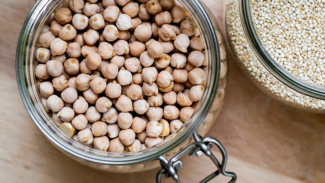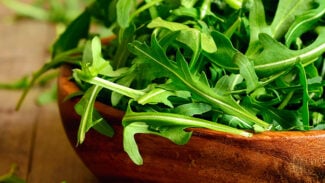Hi Sweet Friends,
Hi Sweet Friends,
Today we’re tackling the topic of protein, which can be a touchy subject in the health world—especially when it comes to animal vs. plant-based protein. And just so you know, this blog isn’t about converting you to a vegetarian or vegan diet. It’s about helping you make healthier, more conscious food choices. No judgment. Just knowledge and love.
I’ve written a lot about animal and vegan protein sources in the past, so I looked back at Crazy Sexy Diet and Crazy Sexy Kitchen while writing this post. I’ve updated some fantastic excerpts from these books, added a bunch of tips and even created a handy infographic for you!
A Protein Myth: The More Protein in Your Diet, the Healthier and Stronger You’ll Be
The belief that we need a high protein intake to be healthy and strong is one of the most pervasive myths in America. In fact, overdosing on protein is one of the reasons we’ve become so unhealthy.
Studies show that as protein consumption goes up, so do the rates of chronic disease. Hello, inflammation! In truth, protein deficiency is virtually nonexistent in industrialized countries.
Is protein important? Absolutely! But as you just read, in large quantities it can harm your health. The trick is to upgrade the proteins we consume and make safer choices on a regular basis.
How Much Protein Do You Need in Your Diet?
How much protein you need depends on your body weight (and a couple of other factors). The USDA’s recommended daily allowance is about 0.36 grams of protein per every pound of body weight (so, at 130 pounds, you’d need about 47 grams of protein daily). I’ve also broken down how to calculate your protein needs and the best plant-based protein sources in my infographic below.
Please note: If you’re an athlete trying to build muscle, are pregnant or lactating, or are under physical stress, use 0.45 when calculating protein needs (so, at 130 pounds, you’d need about 59 grams of protein daily).
Reality check: Are you getting enough protein? The average American adult consumes between 100 and 120 grams of protein every day. Not only is that nearly two to three times what we need, but it also comes from high-fat animal products instead of protein-rich plant foods.

How to Meet Your Protein Needs with a Vegan Diet
Here’s how a moderately active adult who weighs 140 pounds could meet their protein needs (50 grams per day) from vegan protein sources:
- Breakfast: 12 ounces green juice = 2 grams protein | ½ avocado (1.3 grams protein) on 1 piece Ezekiel toast (5 grams of protein per serving) = 8.3 grams protein
- Snack: 1 cup raspberries and ¼ cup raw almonds = 9 grams of protein per serving
- Lunch: Large green salad with ½ cup black beans, ¼ cup raw sunflower seeds with olive oil and brown rice vinegar dressing = 15 grams of protein per serving
- Snack: 10 rice crackers and raw veggies dipped in ½ cup hummus = 13 grams of protein per serving
- Dinner: Broccoli stir-fry served over ½ cup brown rice = 6 grams of protein
- Snack: Green apple with chamomile tea = 1 gram of protein
TOTAL: 54 grams of protein
So clearly, if you’re eating a well-balanced plant-based diet—meaning you’re consuming a wide variety of high-quality protein-rich foods, like vegetables, greens, sprouts, legumes, tempeh, beans, nuts, grains, and so on—then you will certainly be getting enough protein. Even the higher protein needs of pregnant and breastfeeding women and athletes can easily be met just by eating a varied diet of plant-based proteins.
Getting the Right Combination of Protein and Essential Amino Acids
Proteins are long strings of amino acids. There are twenty different amino acids you need for good health, but our bodies can only make eleven of them. The remaining nine are referred to as essential amino acids.
Because we can’t make these essential building blocks, it is essential for us to get them from our diet. Foods that contain all nine essential amino acids are known as complete proteins, although they are not necessarily better protein sources.
While animal flesh is a complete protein source, it’s also “complete” with potentially harmful saturated fat and cholesterol, plus hormones, antibiotics, and oftentimes other unsavory party-poopers like E. coli. And unlike their plant-based counterparts, they lack phytonutrients, water, antioxidants, enzymes, and fiber.
Plants are often touted as incomplete protein sources but many plants have complete proteins providing all the amino acids you need. Quinoa, soy products, buckwheat, and hemp seeds are all vegan protein sources.
Other plant protein sources are only slightly incomplete, so as long as you’re eating a variety of them you’ve got a complete protein powerhouse. You don’t even have to eat them all at the same meal or even on the same day.
The Best Vegan Protein Sources
Without further ado, here are some high-protein vegetarian foods that you can include in your well-rounded diet.
Seitan
Seitan has become a popular staple of vegan diets. It has a high protein content, containing around 25 grams of protein per three-ounce serving. Seitan is made from vital wheat gluten and is one of the best meat substitutes to mimic the texture of meat.
Because Seitan is made from wheat gluten, anyone with Celiac Disease or gluten intolerance should focus on other vegan sources of protein.
Tempeh
Tempeh is a soy-based protein that’s made by cooking and fermenting soybeans. Then they’re pressed into a block. A half-block serving of Tempeh packs a powerful protein punch with 20 grams per serving.
Tofu
Tofu is similar to tempeh, except soybean curds are pressed together (similar to how cheese is made). 3 ounces of tofu contains 9 grams of protein.
Edamame
Edamame is considered an “immature” soybean that must be steamed or boiled to be edible. These extremely versatile beans can be used in salads, stir-fries, and vegan sushi. They also pack a powerful punch with 17 grams of protein per cup.
Soy Milk
Just like tofu and tempeh, soy milk is derived from—you guessed it—soy. Soy milk is a decent alternative to cow’s milk that also provides 6 grams of protein per cup. It’s usually fortified with vitamins and minerals (like calcium, Vitamin B12, and vitamin D).
Lentils
Cooked lentils contain 18 grams of protein per cup and include other key nutrients, such as folate and iron. Lentils also contain over half of your daily protein needs. They’re versatile and can be used in soups, salads, and even curry.
Looking for a lentil-full recipe? Try my 1-Pot Lentil, Potato and Spinach Soup!
Legumes
Legumes, i.e. beans, are another versatile staple of high protein options on plant-based diets. 1 cup of cooked beans contains 14.5 grams of protein. They’re also one of the cheapest sources of protein available. Legumes are full of antioxidants (which can prevent inflammation) and are a great source of fiber.
I’ve created many great bean recipes you have to try!
Hemp Seeds
Just 3 tbsp of hemp seeds contains 10 grams of protein! That’s a pretty high protein content in a small serving (and the most protein of all the seeds). Plus, hemp seeds contain other nutrients like iron, calcium, magnesium and zinc. They’re also a source of omega-3 and omega-6 fatty acids not derived from fish. Hemp seeds are great in salads, granola, and protein balls.
Quinoa (and Amaranth)
Quinoa and other “ancient grains” like amaranth are great sources of protein, containing about 9 grams of protein per cup. They are also unique because they’re complete proteins, whereas most cereal grains are incomplete proteins.
Some great ways to use cooked quinoa include:
Chickpeas
You might have heard these little guys called garbanzo beans, but chickpeas contain 14.5 grams of protein per cup. They’re a great addition to Coconut Thai Curry or Chickpea Tuna Salad and are the base for one of my favorite dips—hummus!
Here’s a few scurmpitous hummus recipes:
Almonds
Almonds contain fat, fiber, and protein. A one-quarter cup serving of raw almonds has around 8 grams of protein. You can eat almonds plain, make your own almond butter, or toss them on your favorite salad. Other nut butters like cashew and peanut can be great sources of fiber, too.
Sunflower Seeds
High protein foods also include sunflower seeds. They’re allergen-friendly, gluten-free, and contain 7 grams of protein per quarter cup.
Pumpkin Seeds
Pumpkin seeds contain 10 grams of protein in 1/4 of a cup. They make a wonderful snack or great addition to a salad for some added crunch. You can even use them in vegan mac & cheese.
Flax Seeds
Flax seeds contain nine grams of protein per serving. They’re high in omega-3 fatty acids and other nutrients and are rich in fiber.
Chia Seeds
Chia seeds are another source of both fiber and protein. Just like hemp seeds, they contain selenium, magnesium, iron, calcium, and omega-3 fatty acids. Chia seeds are a great topping on my Raw Cashew Banana Yogurt (a great replacement for dairy-based greek yogurt).
Broccoli
This little, green guy is another completely allergen-friendly protein source that’s a vegetable. One cup of chopped broccoli holds 6 grams of protein. Give my Broccoli Curry Udon or Vegan Broccoli Salad a try to get your greens in.
Green Peas
Peas are another vegetable that packs a powerful protein punch. Cooked peas are full of protein, with 9 grams per cup. If you want to add protein to a smoothie, pea milk and pea protein can be a great edition.
Kale
Ah, kale. Two cups of chopped kale hold 4.5 grams of protein. Kale is also versatile and can be used in many different ways. Here are some of my favs:
Nutritional Yeast
Nutritional yeast is a deactivated strain of Saccharomyces cerevisiae (that’s a mouthful!). This powdery substance is a great flavorful addition to mashed potatoes or a fun topping to sprinkle on popcorn. Just half an ounce contains 8 grams of protein.
Wild Rice
Wild rice is a surprising source of protein, with 7 grams in a cup. But because wild rice isn’t stripped of bran, it can be commonly contaminated with arsenic. But careful washing and boiling will reduce (if not eliminate) most arsenic contamination.
Spirulina
Spirulina is algae and is also considered a superfood. Why? Just 1 tbsp. of dried spirulina holds 4 grams of protein. It’s the highest source of plant protein in the smallest serving. Spirulina is also full of iron, minerals, and B vitamins. Spirulina is even known to help boost your immune system.
Oats
Dry oats provide approximately 5 grams of protein per half a cup (and are also packed with fiber). Oats can be used to bake bread, make a great alternative to dairy milk, or simply be eaten as oatmeal.
As you can see, vegan diets based on plant foods provide adequate protein necessary for the human body.
Animal Proteins: The Big Picture
Whether or not a particular food is healthy for us doesn’t solely stem from its nutritional value or health benefits. It’s also about how your dinner got to your plate. When evaluating the health consequences of animal products we must also consider the way the critters were raised and treated. Compassion aside, this is about your well-being.
How an animal is cared for from birth to slaughter truly, madly, deeply affects your body. Unhealthy animals create unhealthy food. The unsanitary and inhumane practices of factory farms threaten our food supply. Would you knowingly drink from a polluted well? We must remember that we humans are at the tippy top of the food chain. This means that we eat everything that the critter below us ate and below them ate and so on.
If you want to include animal-based foods in your diet, that’s your choice and I totally honor it (and you!). My advice: keep it to a minimum (two or three times per week), as a garnish or side dish, and make the best selections. According to the American Dietetic Association, a portion of meat shouldn’t be larger than a deck of cards, or the palm of your hand (about 3 ounces).
In addition, do your best to say “no way” to factory-farm products. Instead, look for the Certified Humane Seal, which is the gold standard in farming. As for seafood, Food and Water Watch is a terrific resource to learn what seafood products are safest and, therefore, healthiest. Unfortunately, farm-raised fish often experience similar confinement and health issues. As for wild fish, our oceans aren’t what they used to be and as a result, high levels of mercury (especially in deep-sea fish) and other heavy metals are abundant.
And once you embrace the deliciousness of plant-based cooking, there’s a entire world of whole foods (filled with all the protein you need) waiting to be experienced and savoured.
Your turn: What’s your favorite way to add plant-based protein to your diet?
Peace & protein smarts,












Thank you Kris for this article on plant-based protein. I have not been taking in enough protein for myself. I will be more conscious of doing this…thank you for your positive outlook on life and health. I love the journey I am on. You have a lot to do with that journey.
Your style is very unique in comparison to other people I
have read stuff from. Many thanks for posting when you have
the opportunity, Guess I’ll just bookmark this blog.
Dear All,
You used to hear from me. I was forced to spend almost 6 months in hospital on account of hypertension; but nothing doing.
Home again, I am too disabled to use my NutriBullet the products of which I badly need if I am going to make any sort of recovery. Please, please do you know of any other hassle-free product I can use instead? I certainly hope you do.
I came home reduced to babyhood; forgotten how to use my computer, unable to get into my old address book etc. It is a fluke that I found yours again!
Bethan Morgan
Thank you for this useful information regarding protein. I eat mostly plant protein but 2x a week I add pasture raised eggs for vitamin B12. I also take methylcobalamine as a supplement but not daily, just because I forget. What are other ways I can get in vitamin B12?
The only other non plant food I eat is sheep yogurt, full fat. I just felt it was a way to get in extra protein. Is that unhealthy for my gut? Please advise Thank you and have a great day
L’aloès ou aloe vera (Aloe barbadensis) est utilisé pour ses
propriétés laxatives.
Thank you Kris!!! This is an excellent source of information and I will share with many!
Hi Kris and Team,
Thank you! I love all the easy information. Super inspirational. I was vegan and a Sexy eater/juicer/blender for so long and then I got pregnant and had to expand into dairy and some fish. I couldn’t even look at anything green for my first trimester but now I’m back to feeling human so I’m trying really hard to make the best food choices (and not just eat pasta all the time). I know I need to get back to more plant-based proteins and uncover my sexy self. Thanks for this it will help push me (us) in the right direction! 🙂 -CMR
my husband has a severe allergy to sunflower seeds. If he eats just one seed his head begins to swell. He is having bariatric surgery and needs a high protein drink with NO SUNFLOWER. Do you know of any brand with no sunflower?
Thanks so much Love! I am so excited about eating healthier and feeling more amazing!
what’s a better source of protein spinach or kale
Thank you for your website and all the quality information you share. I watched “Hungry for Change” on Netflix and it changed my life. You were part of that program and I am so inspired by your story and the entire program. I have already ordered your book “Crazy Sexy Diet”. I will continue following you and exploring the recipes you share:). Lastly, the quote that you shared that someone else shared with you, “If you are upset, don’t eat” has been a great insight and a mantra I will memorize. God Bless!
I used to take a lot of regular whey proteins when I was younger and then started to notice my skin would get more ‘rashy’ and dry and also my stomach didn’t feel that good.
Now I’m trying to only take plant based proteins and I feel a lot better.
There’s no need to worry about eating copious amounts of tofu or legumes though, since plant-based protein is a fantastic way to get protein in your diet.
Stay healthy everyone!
Cheers, Jonathan!